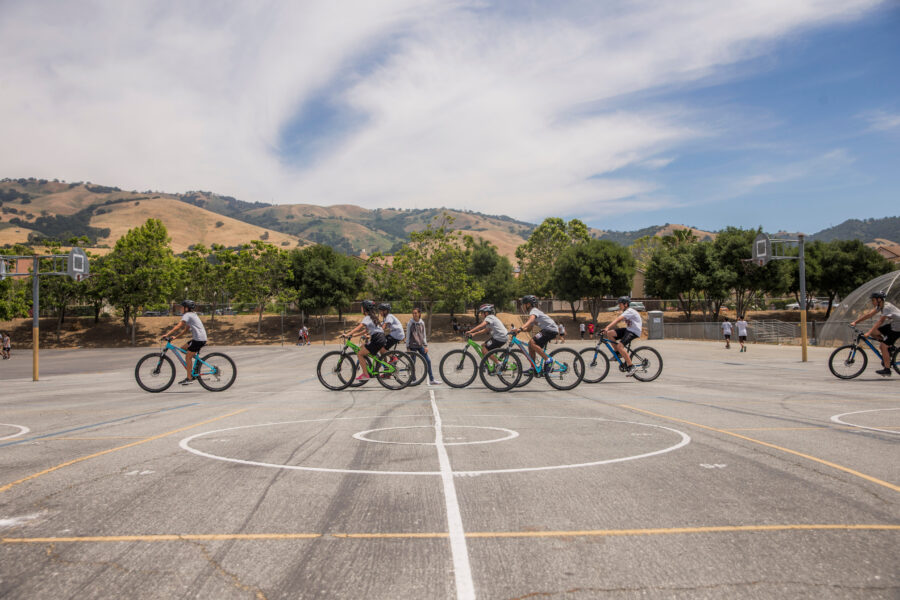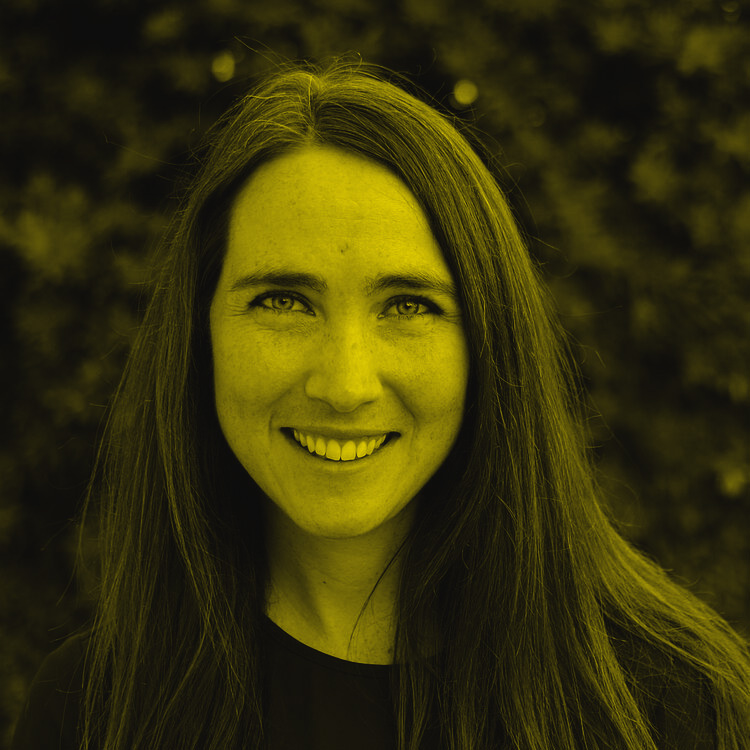10 min. read
Dr. Esther Walker is the Research Manager at Outride, and leverages the power of data and research to demonstrate the impact that cycling has on our social, cognitive, and emotional health. Esther started cycling while working towards her PhD in cognitive science, and hasn’t been able to put down a bike since.
Can you tell me a bit about yourself, how you got involved at Outride, and some of the core tenets of the organisation?
I’m Esther Walker, and am the research manager at Outride. I’ve been here a little over 2 years, and previously was doing a lot of work with research and data science. On the side I also participate in a lot of cycling, not just for commuting but also for recreation and racing. Outride was a unique place where I could combine my strong passion for research and data with helping to get more people riding.
Our mission is to improve the lives of youth through cycling. We have 3 main programming areas: research, school based cycling education, and matching community grants. Through this, we aim to harness the benefits of cycling, while also helping to cultivate inclusive cycling communities, and really helping create pathways for riders of all backgrounds to be part of a vibrant local ecosystem in the USA.
Within the research realm which I oversee, I do a lot of work with applied research with schools and organisations across the US to understand how cycling can make their communities happier and healthier. Through this work we collaborate with researchers and community organisations to answer more specific questions centred around youth cycling, from the very applied level questions around neuroscience, such as “what happens to your brain when you go out for a bike ride”, all the way up to social and policy impacts on community wellbeing.
Within these school and community programmes we use the research to identify gaps, and increase access to equipment and quality programmes and safe places to ride for youth. We also want to ask questions down the line such as,
“Do they [youth participants] develop skills that allow them to break into the bike industry? Do they become advocates for change?”
We of course also look at, particularly after the pandemic, the impact of cycling on youth mental wellbeing, such as the feeling of freedom, wind against your face when cycling when you have been cooped up all day. That’s where this past year we have found a lot on the quantitative side. Students that go out on a bike ride at least once a week report higher levels of mental wellbeing than those who don’t for example. The qualitative side is also compelling. The number of students that are able to get a little time away from being on the internet, all the way to the social connection with the community that that creates, and commenting on experiencing their community and nature in a way they hadn’t before. That inspired us to look at the bigger picture. We know cycling is good for your brain and body but it’s also good for creating social connection and community, so it’s really all encompassing.
Outride’s research on how bikes can impact our brains started with one question: “Can cycling positively impact learning, health, and wellbeing for kids with ADHD?” How are you broadening this question today?
Research has always been the core of what we do at Outride. It’s what motivated our middle school Riding for Focus programme, and what we saw was that cycling could positively impact students with ADHD to feel more focused in class after a morning ride, and helped with academic performance and social relationships as well. However it wasn’t just students with ADHD, it was the whole class that experienced those benefits. Since then, we have continued to expand our programmes. While it’s still an area that we collaborate on with researchers, we are looking at how transformative the bicycle can be for many youths across the country.
Right now there are a few open questions that we are looking into, such as, “What is the long term of introducing bicycling to youth? Do they ride more often after this?”

Can you speak a little about the Riding for Focus school programme, and how the link between Physical Education (PE) courses and every day cycling was made?
Riding for Focus is our middle school cycling education programme. It’s a 12 module progressive programme really designed to be implemented 3 days a week over 6-8 weeks during PE Classes. In the US, PE class is not universally offered, some states don’t have it as a requirement, so we have to be flexible in terms of offering.
The programme is aimed at supporting cycling as a lifelong activity that can really act as an outlet for students to improve their cognitive and physical health as well as their socio-emotional wellbeing. A lot of people have this image of kids learning bikes in sports class and then going off on Red Bull Rampage races, but it’s really not like that. It’s about providing students the ability to gain fundamental knowledge about bike handling, traffic safety, so that they can go out into their community and ride in a safe manner. Of course a key component is that they have fun, that they enjoy it, and it’s something they want to continue doing.
In terms of how connecting the program to everyday cycling, we often will have a conversation once the program has run for 1-2 to two years about how we can expand this beyond the school. When the kids are loving it, the parents begin to care, so we’ve seen a lot of really unique opportunities to build up that ecosystem around their school. Schools may for example develop after school bike programmes. In the programme we develop, they get a free fleet of bikes and helmets, and those become their property, so they can use them however they want outside of the curricular programme.
We’ve seen cases where students work with the teachers to design a trail outside of the school, so they can use that in a shared use agreement with the community. A lot of them also look to connect with groups in their community, such as a cycling coalition for example, and we seek to act as a connector in these communities. That’s often where our Outride fund comes in, where we encourage communities to get interested in starting an after-school programme, or doing other youth cycling work, and build up that larger group of stakeholders. The most successful initiatives have been when the school is a meeting place, and where everyone is on the same level, and are excited to take the programme out in their communities.
Of course, the ability to ride safely in communities across the USA differs widely, so that sparks up a conversation with the local government or leaders, where we can say that cohorts of students can ride safely in their school setting but not in their community, and look to promote improved access to parks and infrastructure. We’re early on in seeing how all these parts fit together research-wise, but the vision is to build those opportunities for students in and out of school.
Outride focuses on increasing access to cycling, targeting historically marginalised communities. Could you expand on these disparities in access to bikes and safe places to ride?
The term bike desert is apt to describe this case. We’ve seen a lot of situations where a school applies for our Outride fund and we find very few safe places to ride around the school, as well as low access to local bike shops that can provide maintenance. That’s where we started to have larger conversations with other bike orgs, such as Free Bikes for Kids or Project Bike Tech, and initiatives around safe routes to school with city planners and governments involved. We have to broaden the conversation beyond our initial programmes, and oftentimes the people in the communities are the best positioned to do that. They have an idea of who needs to be at the table, and what we hope is that People for Bikes or the League of America Bicyclists can come in and help us understand how to best create those connections. Even though we focus on school programmes, it’s really important for us to help create those connections and be able to build these ecosystems in places that are traditionally bike deserts.

Can you give some examples of initiatives that you have supported through the Outride Fund?
The Outride Fund began in 2019 and has really evolved since then. Often, for many communities, it’s not just about recreation but about riding safely. We’ve funded a wide range of initiatives such as supporting a Project Bike Tech, that gives students the ability to learn a skill and will help from an economic standpoint, but also support their community by increasing access to bikes. So the trade and bike mechanics side of things is important. The organisations we support are also very multifaceted, connecting cycling to nutrition, mentoring and other research areas. One example is Mile High 360 in Denver, Colorado. They provide wrap around services for middle school students all the way to high school. Cycling is one component to teach about health, wellness and nutrition, but also to learn about their community. They organise rides where they collect compost and take it to a local garden for example. Or they take their bikes to the library to check out their first book and receive a library card and learn more about access to knowledge and civic institutions. So it really touches upon how the bike can help you move through the world. Of course we also do work around sport and recreation. That same organisation had a group of students interested in going to a cycling event, so they trained for the Steamboat gravel race and the students practised all year to participate, and saw it more of an accomplishment and event than a race. Again, cycling for sport is not necessarily about the competition but about the group coming together to experience parts of Colorado they had never seen, and building a sense of confidence and self esteem that come from accomplishing such a big goal.
So ultimately, we work with a large range of institutions, and a lot of the work isn’t just the introduction to trades and transportation, but also creating avenues for sport and competition if there is an interest.
Can you speak a little more about the importance of role models when working with youth? And how professional riders can inspire youth to cycle in their everyday lives?
Having role models is hugely important to youth. We have recognised early on that not everyone wants to go race the Tour de France. These big sports events are great for creating interest in cycling but they are not the only way. From the surveys we conduct with youth, the number one thing they want to learn is wheelies, jumps, etc. Our ambassadors that can speak to their life experience, show off tricks, and relate to the students are so important. For us, it’s about showing the youth we work with that it’s much more than just road racing. It is great to open their eyes to the world of cycling and see how bikes can be used in the types of visual images they see on the tv but in something they can do in their everyday lives.
Of course, having representatives and role models that are from their community, whether that’s specifically from their state or city, or going through something similar in life, can really create a bond between the students and the ambassadors, and gives them something to look up to in their cycling journey.
Any last thoughts?
The one thing I will add is that in the US in particular, you hear a lot about youth sport, and a pay to play society, getting highly competitive from a very young age, and we actually try to counter that. A key focus to us in our programmes is to make them fun. Without it being fun, kids won’t continue doing it, and so it’s important to provide a supportive environment, where kids can explore and connect with whatever form of cycling is meaningful to them, whether it’s just riding in the park with their friends, learning how to wheelie, or a competitive outlet to challenge their limits. We want to provide programmes that are fun and educational, and don’t have a huge competitive focus, but provide that outlet if needed.

